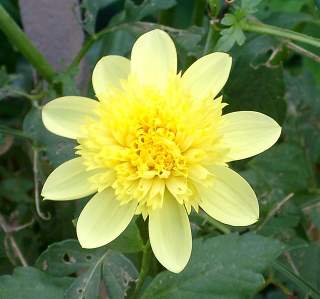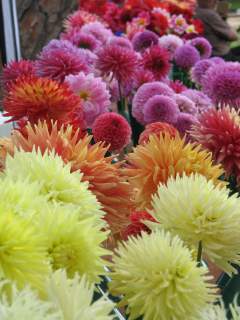
DAHLIAS IN CANBERRA
Dahlias remain one the most reliable and prolific of the summer and autumn flowers that can be grown in our area. They can be used as a spectacular group planting or inter mingled with other garden plants to give a wonderful overall effect. Dahlias come in many different types, colour, size and height. With a little research you can find the one that best suits your needs and add to the overall beauty of any garden.
They will grow in any well – cultivated garden soil, a little extra preparation in late winter by adding some well rotted compost with a little dolomite to the area will improve the result. As they do not like wet feet raising the beds to ensure good drainage can be an advantage in times of heavy rain.
These wonderful plants come in a number of different flower forms such as cactus, semi cactus, exhibition cactus, fimbriated cactus, decorative, semi decorative, informal decorative, waterlily, ball, pompon, collerette, orchid, anemone, stellar and single types with sizes from over 260mm for large types down to pompon and miniature bedding types under 50mm.
Dahlias can be grown from tubers, cuttings or seed. Tubers and cuttings will produce copies of the original plant, seed will give any number of variations there are some gardeners who enjoy the unexpected result and thrill of growing your own new plant from seed. Tuber or cuttings are recommended when you are starting out.
Cuttings are known as green plants and give a strong new single stem plant and are very reliable. These can be taken in spring from new growth when they are approximately 75 – 100mm above the tuber and struck in a medium of sharp sand and a little peat moss and kept just moist in a shaded frost – free area. These should form roots in about three weeks, be potted on and then placed in the garden when about 200mm high.
Planting time in our climate is from late October to New Year, and flowers can normally be expected from mid January to the first frost as long as spent flowers are continually removed.


All types other than miniature bedding should have a stake up to 1.8m high placed in the ground before planting tubers or green plants to avoid damage to new growth if driven in after planting. Short stakes can be used until plants out grow them and higher ones added behind the original if appearance is important. Plant tubers 75mm from the stake and about 100mm deep with the eye or shoot facing up, if more than two shoots appear after planting reduce these to one or two by gently removing them completely from the tuber to give stronger and more manageable plants.
When plants are about 200mm high nip the growing centre out to give a more stable plant that will force the growth to come from the laterals, at the same time the first ties should be made around the stake and main stem to keep the growth upright from the start. Further ties should be made as the plant grows every 300mm, do not allow them to be blown over or stem and plant growth will be very poor. Do not apply any added fertilizer at planting time, as this will produce too much leaf growth at the expense of flower production. Also do not over water after planting as this can cause some rotting of tubers, keep soil just moist at tuber level, once plants are established a drip system can be used once or twice a week with a good mulch applied around the plants.
As plants near flowering some disbudding will improve flower size and stems. Keep plants growing by adding a little fertilizer high in potash as plants begin to flower, after this a fortnightly liquid feed of Prolific or Seasol will keep plants and soil in good condition. It is most important to cut and remove all flowering growth once it has passed its best to encourage the next lot of flowers, failure to do this will cause the plant to form seed heads and stop flowering. Keep plants well tied to the end of the season.
Dahlias will turn black after the first good frost and can then be cut down to about 400mm above the ground to tidy the area. They can then either be removed, divided and stored in a frost – free area until next season or left in the ground until early spring when they should be lifted and divided before replanting. It is not recommended to leave dahlias in the ground from year to year as too many stems will grow and flower and stem size will deteriorate rapidly. When dividing dahlia clumps remember that tuber necks must not be broken and must have a section of last seasons stem growth attached to each tuber, as this is where the growth eyes come from not the actual tuber that feeds the new growth.
Good dahlia tubers for garden or exhibition purposes are normally available at reasonable prices from the plant stall at the Horticultural Society of Canberra Inc. spring shows in October and November.
Further dahlia tubers can be obtained from the Dahlia Society of NSW/ACT Inc. meetings in September and November. This Society meets at the Mittagong RSL Club on the first Saturday of January, May, July, September and November. Details can be had from the secretary on ph. 02 69475243 or locally on 62812865.
For more comprehensive information on this subject, please refer to the latest chapter of the Canberra Gardener









